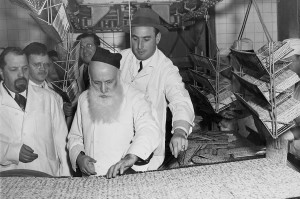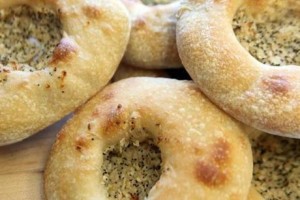That was the slogan on Madison Avenue during HG’s heyday as a New York/New Jersey public relations biggie during the 60’s and 70’s. HG no longer dresses British. Sweatpants and hoodies are more HG’s style. But, HG sure likes to eat Yiddish. Noo Yawk provided the goodies for the HG/BSK and R. family traditional smoked fish feast (a riff on the Italian Seven Fishes tradition) on Christmas Eve. Zabar’s provided red salmon caviar, potato salad, cole slaw and a Jewish rye bread. Russ & Daughters was the source for Nova Scotia (Gaspe Bay) smoked salmon, sable, pastrami cured smoked salmon, tobiko roe, horseradish cream cheese, scallion cream cheese and (a bow to carnivores) chopped liver. Kossar’s, one of the last traditional Jewish bakeries, sent bagels, bialys, onion rolls and a cinnamon babka cake. Sliced onions, olives, sour cream, pickles, capers and lemon wedges were on the table. Lesley R. made yummy blinis and crepes for the caviar and sour cream. Plus a celeriac slaw. Vodka and beer chasers for HG. Chilled white wine for the sensible family members. Though Face Time helped, SJ, Exquisite Maiko, Handsome Haru and Super Cute Teru, were much missed.
Think Yiddish, Dress British
December 27th, 2017 § 0 comments § permalink
“Cool” replaces Kosher on the Lower East Side
April 25th, 2016 § 0 comments § permalink
Passover is upon us and HG is filled with memories of the traditional food and drink from the Seders of HG’s youth. The Seder is the traditional meal at the beginning of Passover when the family reads from the Hagadah, a celebration of the escape by the Jews from Egyptian slavery. (HG, in previous posts, has recalled raucous and irreverent Seders of the past). The food most identified with Passover is the matzo, the unleavened bread that sustained the Jews during their hasty exodus. HG’s late Mom always insisted on Streit’s, a matzo baked for decades in antique ovens on Rivington Street in the Lower East Side. Founded in 1915, Streit’s closed its Rivington Street factory in 2015 and moved to New Jersey, ending a 90 year Manhattan history. Wasn’t gentrification. For years, the family turned down numerous offers to sell their property to real estate developers. The old ovens didn’t work anymore and no one knew how to repair them. Mom always insisted on Horowitz-Margareten egg matzos (HG’s favorite). Horowitz-Maragreten disappeared from New York and (along with Goodman’s, another New York matzo company) was bought by the giant Manischewitz company. Manischewitz’s is owned by Bain, the Boston investment firm once headed by Mitt Romney (Oy Vey!!). Schapiro Wine Company was another Rivington Street landmark. Founded by Sam Schapiro in 1899, the company closed its Lower East Side winery in 2000. Had a brief run as a winery in Monticello, N.Y. Schapiro wine was very sweet (loved by HG’s Mom and despised by HG’s Father). Its motto: “Wine So Thick You Can Almost Cut It With A Knife.” The cool, cool Lower East Side is now filled with expensive condos, art galleries, trendy bars and restaurants, cutting edge fashion shops. The only remnants of traditional Jewish eating are Katz’s Delicatessen, Russ & Daughters Appetizing Shop and Cafe, Yonah Shimmel’s knishes and Economy Candy. A bit of happy news. Kossar’s Bagel and Bialy Bakery has re-opened (after closing for a few months) in totally refurbished premises at 367 Grand Street. Traditional products like bialys and pretzels (onion rolls) are still great but there are some aberrations. Apple/cinnamon bialys, alas.
Nostalgia Sucks – An SJ Posting
February 29th, 2016 § 4 comments § permalink
Ahhh…Nostalgia. So wonderful and yet so full of shit. SJ here and I must make a rebuttal against HG’s colorful yet ill informed attack against the New York of now versus the New York of HG’s past. As someone that has lived in New York for the most part of my 47 years (and is living here still), I must say that HG speaks some truths: New York has become painfully expensive for middle class and working class people and really anyone who is not making a high six figure income. And yes, many wonderful New York institutions have closed down as rents increase. And finally, it is true that the essentially secular Jewish character of New York is fading while the religious Chassidic population is rising. These are painful truths for a changing city. But, there are many things that have not changed one iota. HG claims that New York has pushed out Mom and Pop stores in favor of chains. Lies! While big chains have arrived in an unprecedented fashion, New York still remains (for the moment) a place of corner bodegas, grumpy news stands, eccentric hardware stores and family run bakeries, delis and food shops. I live in Carrol Gardens, Brooklyn and I have a shop in Chinatown in Manhattan and in this tiny universe generic chains have barely made a dent (with the exception of Starbucks and the actually welcome addition of Trader Joe’s and Whole Foods). Now onto food….HG makes a claim that New York restaurants have all become ridiculously overpriced and only serve fussy, so-called “creative” small plates that highlight kale. Well, those nostalgic goggles HG is wearing have become so fogged with BS, that he has no clue what he is talking about. (HG! Time to stop reading New York Times restaurant reviews and actually visit and eat!) While there are many trendy, overly precious restaurants (as there were back in HG’s day — remember “continental cuisine” or that rash of horrible hippy bean-sprout “health food” restaurants that propagated in the 70s?), there are also scores and scores of simply great places to eat that are making food that is honest and delicious and actually responsible with their ingredient sourcing and their investment in nose-to-tail eating. On a mainstream level, we now have restaurants that celebrate regional cuisines from Puglianese Italian to top notch Texas style Barbecue to authentic Barcelona style Tapas — a long way from the very good but very one note Italian and Spanish restaurants of yester-year; furthermore, even outside of ethnic enclaves, New York has exploded with amazing Japanese, Korean and other Asian foods. And, if you want to speak of cheap food, well jump on a train to Flushing, to Sunset Park, to Ozone Park or walk into Manhattan’s Chinatown and you will be flush with $4 chorizo tortas, smokey Xian style Chicken skewers for $1, Thai Sausage for $3 and a plethora of inexpensive vittles to make you smile. And yes, the great dairy restaurants of the past have shut down, but guess what? Now there are Uzbeck kosher restaurants popping up all over with delicious grilled meats and wholesome stews; and if you want to be a healthy Jew who eats like IB Singer, well there has never been a better time for vegetarians in this city both with mainstream restaurants and many serious Israeli spots serving hummus, falafal and all sorts of healthy middle eastern treats. Lastly, when it comes to traditional New York food and specifically Jewish food, there is a renaissance happening: Katz’s may have gone downhill (but their hot dog is still something killer!), but Mile End is making some incredible smoked meats; Russ and Daughters and Kossar’s are fully revitalized and thriving, serving up perhaps the best food of their long careers; Barney Greengrass is packed every day of the week and a new generation of bagel makers, smoked fish lovers and matzoh ball soup mavens are opening wonderful restaurants. And with food blogs popping up everywhere old, great NYC restaurants and shops have been given a new life as can be witnessed in the hours long lines for Casa Della Mozzerella on Arthur Avenue or the incredible community support that kept B&H open after a gas explosion totaled their block last year. So HG, SJ is advising that you take a cloth to your nostalgia goggles and take a second look at a New York that, while changing as it always has, remains an idiosyncratic and uniquely great place to live, eat and wander about.
Ray Of Sunshine
December 2nd, 2015 § 0 comments § permalink
Some pleasant news for a change. The beloved Bialy is making a comeback (at least in New York, although they never really traveled beyond that city’s borders). The Bialy (full name is “Bialyostoker kuchen”) is a roll with an onion flavor (plus some fried onions clinging to the surface) and a chew like the crust of a very good pizza. It was created by Jews toward the end of the 19th century in the Polish city of Bialyostok. Jewish immigrants brought it to New York’s lower east side at the turn of the century and it quickly became a New York staple. For many decades, New York’s Jewish and non-Jewish working population started their day fueled by coffee and a “Bialy with a shmear (cream cheese).” Sadly, true bialys virtually disappeared a few years ago. Now, it’s back. Kossar’s, once the only reliable bialy source in New York (founded in 1936), closed but will reopen this year at a new and expanded space on Grand Street. Meanwhile (according to Jewish food authority Leah Koenig), Hot Bread Kitchen is selling good bialys at various food markets. In Brooklyn, Shelsky’s (the appetizing store) and Mile End (the delicatessen) are offering authentic bialys. Bagels, of course, are now universal. Horrors like chocolate chip bagels and blueberry bagels can be found at every supermarket. Of course, these bear no resemblance to the old fashioned boiled and then baked New York bagel. HG was never fond of bagels, either those of yesteryear or today’s aberrations. Always loved bialys. Kossar’s promises a revamped website for efficient ordering of bialys online. Happy news.
Best Baked Goods
November 20th, 2014 § 0 comments § permalink
HG often longs for the great breads of HG’s Bronx youth. Rye bread. Pumpernickel bread. Bialys. Onion “pletzels” (rolls). A number of grocers offer “Jewish” rye bread. HG believes this is an affront that calls for investigation by the B’nai Brith Anti-Defamation League or even more drastic action by the Jewish Defense League. Dismal present day for HG’s favorites. Pumpernickel bread? Insipid. Bialys? Other than Kossar’s, they are pale imitations without that unique oniony flavor. “Pletzels” ? They’ve disappeared. Bagels, of course, are a sardonic joke. HG doesn’t care because HG never liked bagels. Bagel lovers deserve the nasty chocolate chip and cinnamon raisin bagels now being offered. However, there’s hope. Recently, HG ordered Zabar’s sourdough seeded Jewish rye and Russian pumpernickel bread. Made HG’s eyes misty. These are the authentic loaves. Topped with scallion cream cheese and smoked fish. HG devours many slices with glasses of icy vodka (This regime draws frowns from BSK but HG shakes off disapproval). Another happy note concerning traditional Jewish baked goods. Restaurateur Daughter Victoria sent HG some “Traditional Raspberry Rugelach” (from Russ & Daughters). Spectacular. Sorry, Mom in Heaven, better than yours.
Feast Of The Seven Fishes
December 27th, 2013 § 0 comments § permalink
Christmas Eve. Time for the Feast of the Seven Fishes. The Russian-Jewish-Italian-English-Irish-Japanese-American-Canadian HG/BSK family gives this Italian tradition a twist by focusing on smoked fish from New York’s venerable Russ & Daughters. SJ brought the goodies from New York) with a stop at Kossar’s Bialys for authentic bialys and great bagels). There were two kinds of herring (Fresh fillets from Holland and German-style roll mops). Three kinds of smoked salmon (Western Atlantic Nova, Gaspe Bay Nova and Double Smoked Danish). Two types of caviar (salmon and topiko). Sable. And, R & D’s signature chopped whitefish and baked salmon salad. Count them. Nine seafood varieties. The family believes in abundance. Olives. Capers. Three varieties of cream cheese. Sliced onions. Celeriac salad. Hearts of Palm and tomato salad. Sour cream. Creme fraiche. Gifted Daughter Lesley R. made blinis and delightful crepes enriched with buttermilk. HG drank (okay, guzzled) lots of icy vodka and ale chasers (drawing some frowns). Other family members practiced moderation. Wonderful, joyous feast. A happy family tradition.
When Muffins Met Modernism & A Jewish Bakery Detour
June 13th, 2012 § 0 comments § permalink
In 1930s New York, many apartment buildings, shops (and restaurants) were designed in a streamlined, modernist style — a kind of Art Deco for the masses. While true Art Deco (which reached its height in Paris of the 20s and 30s) was very elegant and seriously luxurious, the young American designers who piggy backed on the Art Deco style were a bit more egalitarian. Their best efforts, in terms of major structures, can be seen in the apartment houses that line the Grand Concourse in the Bronx and the glorious hotels of Miami’s South Beach. Smaller design gems were the chain bakeries that flourished in all of New York’s neighborhoods. The aim of all the “streamlining” was to give shoppers an optimistic lift in the gloom of the Great Depression. The “streamlined” bakeries were Cushman’s and Hanscom’s. The famed industrial designer Raymond M. Loewy designed Cushman’s and Horace Ginsbern designed Hanscom’s. (Ginsbern, then fairly young, later became one of New York’s most prominent apartment house architects. Ginsbern was born in 1893 and died in 1969. Scores of his buildings exist in Manhattan’s Upper East Side).
The architect Robert A.M. Stern has commented on the Loewy and Ginsbern bakery designs: “They brought a relatively high level of International Style Modernism into virtually every New York neighborhood.”
Cushman’s had white porcelain facades; nautical, oval windows and the name was spelled out in a curving, gold script. Hanscom’s had apple green porcelain facades and the name was formed with blocky, super- modern letters. Stern described the entire architectual composition as “Constructivist.”
In the Bronx you had Jewish Bakeries and Italian bakeries. The Jewish bakeries had elaborate butter cream cakes and, of course, bagels, bialys, rye and pumpernickel bread, etc. These were jammed on Sunday mornings with Dads buying bread-stuffs for brunch (The casual tweed and camel hair jackets many of them wore were known as “bagel coats”). The Italian bakeries, in neighborhoods like Belmont, had, of course, sublime bread, delicious cannolis, pignoli cookies and other Italian specialties. There was plenty of cross pollination. Jews liked the corn muffins and cookies at Cushman’s and Hanscom’s (which were generalized as goyish bakeries) and there were plenty of bagel and rye bread fanciers among the non-Jewish population. And, of course, everyone loved their Italian baked goods. Some Jewish bakery survivors in Manhattan are Moishe’s Bakery on 2nd Ave, Streit’s, which bakes and sells matzos, macaroons, kichel and other stuff from a 47,000 foot factory on Rivington Street and Kossar’s which bakes and sells bialys and other traditional good stuff from a location near the Essex Street Market. SJ sent HG a batch of Kossar’s products a few months ago producing moans of delight. The eminent food writer, Mimi Sheraton, a woman who knows Jewish food, says a Kossar’s bialy is the only true bialy baked in the United States. HG agrees.
Interestingly, HG’s Mom never called a bialy by that shortened name. She paid appropriate homage by calling it a Bialyosteker Kuchen.






